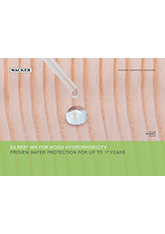
Reach for the Heights!
Building on inaccessible ground? To a height of 2,224 meters? Why not, provided you have the right material? That is precisely why wood is the traditional building material in the Alps. Of course, the natural raw material is also extremely welcome in cities and conurbations.
At the summit
An impressive example of modern wood construction can be seen on the Nebelhorn, in the German Allgäu district. The best material for constructing the mountain-top restaurant here, at a height of 2,224 meters, proved to be wood. Wood conforms to every change in the weather - even if the temperature falls ten degrees in a few hours, or if it begins to snow heavily and the air humidity consequently soars. Well-impregnated wood will not be damaged. There were also good architectural reasons for choosing wood on the Nebelhorn: with no road leading to the mountain peak, the construction companies had to rely on the cable car and helicopter for transporting the material. The top priority was to save weight. That’s child’s play with wood, since, compared to other construction materials, wood is lighter for the same strength. Weight for weight, it can carry 14-times as much load as steel and has the same compressive strength as reinforced concrete. In addition, the components can, for the most part, be prefabricated and impregnated before transportation up the mountain for assembly. This saves both time and money.
Up and Away

Until the 1990s, wood construction was common practice in rural areas, especially in the Alpine regions. But for some years, natural construction materials have been in demand especially in urban areas. With wood near the top of the developers’ and architects’ wish list. The catalog of flagship projects is long: an apartment house in Berlin-Prenzlauer Berg is the first seven story building in Germany to be made of wood - rising to a proud height of 22 meters. In Milan, Italy, a residential estate with four nine-story towers and 124 apartments is currently being constructed. The highest wood building at present can be found in London - nine stories, 30 meters, high. Even the staircases and elevator shafts are made of wood. The highest wooden skyscraper, at 50 meters height, is in Bergen, Norway. In Vienna, too, they are experimenting with wooden high-rise buildings: the house is planned to rise to 84 meters high - with apartments on 24 stories. The facade is designed to look like tree bark. The high-rise building will comprise 75 percent wood.
Built-In Comfort Factor
Wooden houses are the architecture of tomorrow. And wood also offers technical advantages as a construction material. Under high atmospheric humidity, wood stores moisture in its cell structure and releases it again when the air is dry. That makes wood a natural regulator for the indoor climate In composite construction materials reinforced with cellulose fibers, with a high porosity, wood also shows good thermal insulation values. The surface temperature is always pleasant and most people feel at ease in rooms containing a great deal of wood. However, it is not conducive to a good climate if the wood becomes saturated with water and promotes the growth of mold. By absorbing and emitting water, wood swells and shrinks again causing severe damage to the surface. This also speeds up the rotting of wood surfaces. Impregnation, for example with silicone resins, which form a coating that is both water repellent and water-vapor permeable, help to protect against weathering and prevent the resulting structural damage. Correct treatment preserves the wood for many years, as a highly welcome and modern construction material.
Silicone Resins as Wood Preservatives
Under the trade name SILRES® WH, WACKER offers a range of silicone resins for wood protection. For more information, see our product portal..
To the product portal





